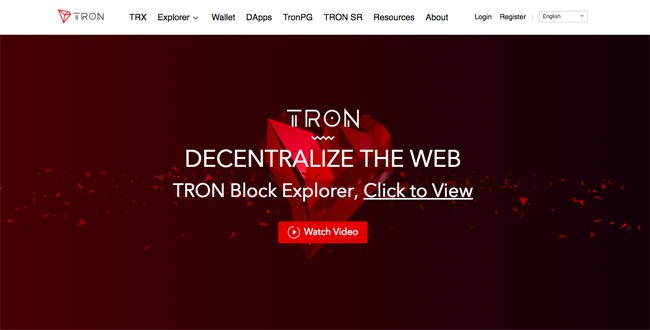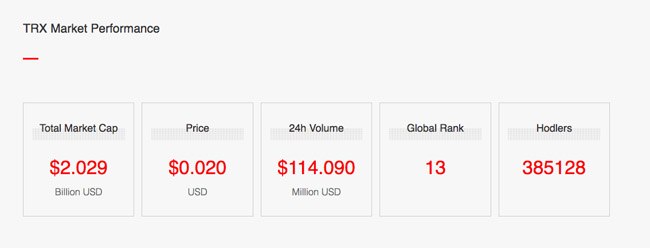If you remember the internet from the early part of the 21st century you’ll recognize that the balance of power has shifted greatly in the past two decades. What was once a free and open medium has become dominated by the world’s giant corporations.
Advertising is now used to feed content to users in a much more insidious fashion than ever before. Billion dollar retailers like Amazon and Wal-Mart dictate what products are popular, and which are buried in obscurity.
Through this behavior we can see how the internet has become increasingly centralized.
Because of this, here are many crypto-projects that are beginning to offer up decentralized options that allow users to share and receive news, music, video and social media from a blockchain based solution with no ties to corporate interests. One such project is Tron.
Tron Review: What is Tron and TRX
Tron is a blockchain operating system, but its primary use case thus far has been as a “blockchain based entertainment system” that will allow for original content to be spread around the web easily and freely.
It’s a fairly new blockchain project, having been founded in 2017 by the Singapore-based non-profit Tron Foundation. As a decentralized blockchain contect sharing platform, its goal is the disruption of the trillion dollar entertainment industry, including such internet juggernauts as YouTube.
The medium of exchange on the Tron platform is the native cryptocurrency TRX. Because Tron uses a native currency, it is ideal for interactions between the ordinary users and content consumers and the content creators and providers.
One of the benefits of this is that content creators will no longer have to give up their content for whatever platforms like YouTube decide to give them, and content providers are no longer at the mercy of the high fees and commissions charged by the likes of the Apple App store and Google Play.
Content consumers can benefit from the Tron platform through incentives being paid out for sharing content, whether that be live and recorded video, images or even text.
Tron is trying to get rid of the middleman in internet entertainment by leveraging the combination of peer-to-peer networking and blockchain technology. This will allow content creators to directly reach their audience and more easily and profitably monetize their content.
Tron Review: The Tron Mission
From the very beginnings Tron has been under fire from various directions due to its aggressive marketing and allegations of plagiarism. In January 2018 there were allegations that a great deal of the Tron whitepaper had been plagiarized. Tron’s CEO, Justin Sun, blamed the similarities in the English version of the whitepaper on poor translations from the volunteer translation team.
There have also been complaints of Tron’s habit of changing its stated mission and value proposition. Initially the Tron Foundation promoted the platform as a decentralized entertainment sharing platform, with a focus on social apps, gaming and gambling, but more recently they have shifted gears and Tron is now being promoted as a decentralized operating system to decentralize the web and “heal the internet”.
Tron Review: The Tron Ecosystem
Tron is comprised of a 3-tier model that includes a blockchain layer, a peer-to-peer distributed storage system, and an application interface layer.
The blockchain layer of Tron works on a delegated Proof-of-Stake consensus model and is a smart-contract platform. The peer-to-peer storage system is distributed data storage that includes all of the data shared on the platform. And the application interface layer controls access to the content that is shared on the platform.
The delegated Proof-of-Stake mechanism used by Tron is called TPoS and it features 27 super representatives that are elected by the community of TRX holders. These super representatives act as validating nodes on the network, verifying transactions and receiving a commensurate reward.
Voting rights for TRX holders are influenced by the length of the holding period of the TRX tokens. The longer the tokens have been locked and held, the greater the weighting of each vote.
Tron Review: TRON Roadmap
The Tron Foundation has laid out a six phase roadmap that spans six years as follows:
- Exodus: This first phase is the creation and release of a free P2P data sharing platform to distribute and store user content;
- Odysseus: The second phase will incentivize content creators by expanding user rights to content;
- Great Voyage: The third phase is planned to implement a personal ICO that allows users to launch their own personal crowd-funding campaigns;
- Apollo: The fourth phase allows for the issuance of personal tokens on the Tron platform. These will be known as TRON-20 tokens;
- Star Trek: The fifth phase is scheduled to enable a decentralized platform for online gaming and prediction markets;
- Eternity: The sixth and final planned phase envisions the ability to fundraise and monetize based on the community growth.
Other Key Aspects of the Tron System
Social Media Platform – Tron works exceptionally well as a social media platform, allowing users a free exchange of thoughts, ideas, images and video without the intervention of a third-party.
Decentralization – Because Tron is blockchain based it is also decentralized, which means as long as there are users it can’t be shut down. The security and transparency of the blockchain allows users to maintain full control over their digital assets. And users who share good content can be rewarded by the system or by other users. This system also allows for a distributed exchange, forecasting and autonomous gaming.
Freedom of Data – The Tron network has no censorship of the media being shared and stored. This maintains complete freedom of data and freedom of speech, with no worries that corporate interests will change or remove anything added to the network. Furthermore, user need not worry about being removed from the platform for arbitrary reasons.
Incentives – One underrated aspect of Tron is the ability to stimulate growth of specific ecosystems within the network through the use of incentives.
Personal ICO Option – Users have to option to “freely distribute digital assets in the form of an ICO”. As a result of this, other platform users can enjoy the benefits and services that are delivered via the “continuous development of data contributors by purchasing digital”
Payment Network – Because Tron has its own native token, the TRX, it can be used as a global payment system. Users can send or receive payments to other users anywhere in the world, and the payments arrive in minutes. Additionally, the transactions are fully encrypted and are only accessible to the parties directly involved in the transactions.
Tron Review: About the Tron Foundation
The Tron Foundation was initially created to develop a platform for cutting edge digital innovation. Its founder and CEO is Justin Sun, who also founded the CallMe (Peiwo) voice calling app in China. In addition to heading the Tron Foundation, Sun is the CEO of BitTorrent, a peer-to-peer streaming service that was acquired by the Tron Foundation in July 2018.
The company has been approved by institutions such as the Accounting and Corporate Regulatory Authority (ACRA), and is run by the Board of Trustees or the Board of Governors formed by eligible individuals for independent management and operation, which is also independent from the government’s administration.
Tron Review: TRON TRX Token Details
Tron held an ICO in September 2017, releasing 100 billion TRX and meeting its hard cap of 15,000 BTC within three days.
The TRX token is pronounced “Tronix” and there is a circulating supply of roughly 65 billion TRX. The Tron Foundation holds roughly 35 billion TRX and has committed itself to periodically burning coins to keep supply constrained and raise demand for the TRX token.
In terms of the allocation of the 100 billion total tokens, the company has presented the following model:
- Public offering: 40%
- TRON Foundation and the ecosystem: 35%
- Private offering: 15%
- Pay initial supporter-Pei Wo Huanle (Beijing) Technology Co., Ltd.: 10%
The ICO price of TRX was $0.002 and the token has seen an all-time high of $0.2548 on January 4, 2018. While it’s declined significantly from that all-time high, it is also considerably higher than its ICO price. As of September 2018, just one year after the ICO, TRX is trading at $0.0226, which is more than 10 times its issue price.
TRX tokens can be purchased primarily with BTC, ETH and USDT, although there are some fiat currencies supported on a limited number of exchanges. The largest trade volume in TRX is on Binance, but there are a large number of other exchanges that offer TRX including Upbit, Bit-Z, OKEx, Huobi and others.
Tron Review: Conclusion
Tron is an interesting project and given the growth in the value of its native token it’s also one that is attractive to users and investors.
That said, there have been some red flags to the platform, including the potentially plagiarized white paper and the false rumors of the sale of some 6 billion TRX by founder Justin Sun. Even though that rumor was proven false, there have been some allegations that it was engineered as a pump and dump scheme.
While users will no doubt flock to a free, decentralized and censorship-free platform such as Tron, there’s some concern over infringement’s of the legal rights of other entities, and this could lead to massive lawsuits in the future. I wonder how the Tron Foundation will address and handle such a situation.
In the meantime the Tron platform has continued growing, recently adding BitTorrent as an asset, and moving to its own main net with a native currency rather than one based on Ethereum.
As the #13 coin by market cap TRX has a lot going for it, and it’s certainly worth keeping an eye on. We all know how young the cryptocurrency industry is, and there’s no telling where the value of many of these projects will head in the coming months and years.

